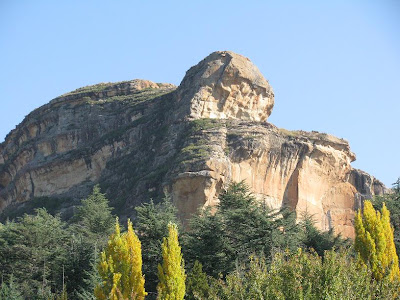 What was our ultimate destination as we meandered through the countryside of the Free State?
What was our ultimate destination as we meandered through the countryside of the Free State?Wyndford Holiday farm, established in the 1920's, first visited by Richard, our girls and I some twenty odd years ago. Little has changed since then. The rhythms of Wynford depend on the bell - to summon one to tea and cake, scones or biscuits at ten and four o' clock served in the summer house. To summon one to breakfast, lunch and dinner in the cosy dining room where guests are seated with strangers, where tired city dwellers who haven't said a cordial 'Hi' to a neighbour in years, find themselves sharing their histories over homely dishes of wholesome fare.
 Jaelene spent hours swinging (me, pushing) doing puzzles, watching the resident tortoises move slowly into the morning sun, feeding scampering bunnies and chickens, riding horses and chatting to Gran on the lawn.
Jaelene spent hours swinging (me, pushing) doing puzzles, watching the resident tortoises move slowly into the morning sun, feeding scampering bunnies and chickens, riding horses and chatting to Gran on the lawn. Joelle was the star of the stay - a fearless six-year old who went hiking twice a day on the mountains, wriggled through bat caves, swung through the air (safely helmeted and harnessed) on a slide high above the tree tops and even attempted to ab-sail down cliffs ("Not this time, next time, Mom, when I'm in big school!)
Joelle was the star of the stay - a fearless six-year old who went hiking twice a day on the mountains, wriggled through bat caves, swung through the air (safely helmeted and harnessed) on a slide high above the tree tops and even attempted to ab-sail down cliffs ("Not this time, next time, Mom, when I'm in big school!) Cell phones don't work among the mountains surrounding Wynford so no-one leaps up from the table to rush outside and talk far too loudly about deals, emails, faxes and appointments.
Cell phones don't work among the mountains surrounding Wynford so no-one leaps up from the table to rush outside and talk far too loudly about deals, emails, faxes and appointments. Memories are made at Wynford. Ours stretch over three generations and twenty-five years: Richard and I, our daughters and now the grandkids.
Memories are made at Wynford. Ours stretch over three generations and twenty-five years: Richard and I, our daughters and now the grandkids. As I packed my suitcase in my little cottage room to return home, I found a forgotten scrap of paper tucked in a side pocket, covered with Richard's loopy scrawl. A coincidence? The Westminister Confession speaks of the 'communion of the saints'; the writer to the Hebrews reminds us of the 'cloud of witnesses' watching our earthly journey and encouraging our perseverance as saints. So is it too unorthodox to think of a beloved husband, a proud dad, a grandfather who never knew his grandchildren, looking down on the new memories being made among the crags at Wyndford?
As I packed my suitcase in my little cottage room to return home, I found a forgotten scrap of paper tucked in a side pocket, covered with Richard's loopy scrawl. A coincidence? The Westminister Confession speaks of the 'communion of the saints'; the writer to the Hebrews reminds us of the 'cloud of witnesses' watching our earthly journey and encouraging our perseverance as saints. So is it too unorthodox to think of a beloved husband, a proud dad, a grandfather who never knew his grandchildren, looking down on the new memories being made among the crags at Wyndford?






































